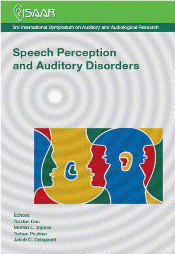Tinnitus, hyperacusis and their relation to hearing loss in professional symphony orchestra musicians
Abstract
Background: Musicians are exposed to loud sounds which can lead to hearing loss and hearing associated symptoms such as tinnitus and hyperacusis. Tinnitus and hyperacusis may be particular predominant in a population of musicians since musicians especially pay attention to audiologic symptoms. However, tinnitus and hyperacusis may or may not be associated with hearing loss. Purpose: To investigate the association between subjective hearing symptoms and objective hearing thresholds. Methods: Questionnaire data from 351 musicians from five symphony orchestras were used to estimate the frequency of subjective hearing loss, tinnitus and hyperacusis. Data from user operated Two Alternative Forced Choice Audiometry were available from 223 musicians and 199 of these included questionnaire data as well. Results: Subjective hearing loss was significantly (p<0.001) related to the hearing thresholds. Tinnitus was not related to the hearing thresholds in musicians. Subjects with hyperacusis were shown to have better hearing thresholds compared to musicians without hyperacusis. This was significant for the left ear after correction for age and gender (p<0.02). Conclusions: Auditory symptoms such as tinnitus and hyperacusis were not related to a reduced sensitivity in musicians. Hyperacusis was shown to be associated with a more sensitive hearing in musicians.
References
Axelsson, A. and Lindgren, F. (1981). Pop music and hearing. Ear Hear., 2, 64-69
Baguley, D. M. (2003). Hyperacusis. J R.Soc Med., 96, 582-585
Eggermont, J. J. and Roberts, L. E. (2004). The neuroscience of tinnitus. Trends Neurosci., 27, 676-682
Jansen, E. J., Helleman, H. W., Dreschler, W. A.,de Laat, J. A. (2009). Noise induced hearing loss and other hearing complaints among musicians of symphony orchestras. Int.Arch.Occup Environ Health, 82, 153-164
Kähäri, K., Zachau, G., Eklof, M., Sandsjo, L.,Moller, C. (2003). Assessment of hearing and hearing disorders in rock/jazz musicians. Int.J.Audiol., 42, 279-288
Laitinen, H. and Poulsen, T. (2008). Questionnaire investigation of musicians' use of hearing protectors, self reported hearing disorders, and their experience of their working environment. Int.J.Audiol., 47, 160-168
Lockwood, A. H., Salvi, R. J.,Burkard, R. F. (2002). Tinnitus. N.Engl.J.Med., 347, 904-910
Schmidt, J. H., Brandt, C., Christensen-Dalsgaard, J., Andersen, T., Bælum, J., and Poulsen, T. (2010). "Test person operated 2-Alternative Forced Choice Audiometry compared to traditional audiometry" in: Proceedings of ISAAR 2009: Binaural Processing and Spatial Hearing (2nd International Symposium on Auditory and Audiological Research.Elsinore, Denmark. Edited by J. M. Buchholz T. Dau J. Christensen-Dalsgaard and T. Poulsen. ISBN 87-990013-2- 2. The Danavox Jubilee Foundation Copenhagen), 381-390.
Schmidt, J. H., Pedersen, E. R., Juhl, P. M., Christensen-Dalsgaard, J., Andersen, T. D., Poulsen, T.,Baelum, J. (2011). Sound Exposure of Symphony Orchestra Musicians. Ann.Occup.Hyg., Doi:10.1093/annhyg/mer055,pp 1-13
Schmuziger, N., Patscheke, J.,Probst, R. (2006). Hearing in nonprofessional pop/rock musicians. Ear Hear., 27, 321-330
Shargorodsky, J., Curhan, G. C.,Farwell, W. R. (2010). Prevalence and characteristics of tinnitus among US adults. Am J Med., 123, 711-718
Woolford, D. H. (1984). Sound pressure levels in symphony orchestras and hearing. Presented at 1984 Australian Regional Convention September 25- 27.Melbourne., Preprint 2104, 1-27
Additional Files
Published
How to Cite
Issue
Section
License
Authors who publish with this journal agree to the following terms:
a. Authors retain copyright* and grant the journal right of first publication with the work simultaneously licensed under a Creative Commons Attribution License that allows others to share the work with an acknowledgement of the work's authorship and initial publication in this journal.
b. Authors are able to enter into separate, additional contractual arrangements for the non-exclusive distribution of the journal's published version of the work (e.g., post it to an institutional repository or publish it in a book), with an acknowledgement of its initial publication in this journal.
c. Authors are permitted and encouraged to post their work online (e.g., in institutional repositories or on their website) prior to and during the submission process, as it can lead to productive exchanges, as well as earlier and greater citation of published work (See The Effect of Open Access).
*From the 2017 issue onward. The Danavox Jubilee Foundation owns the copyright of all articles published in the 1969-2015 issues. However, authors are still allowed to share the work with an acknowledgement of the work's authorship and initial publication in this journal.


